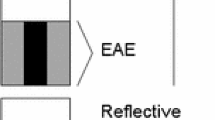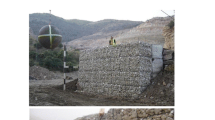Abstract
An Eulerian formulation is necessary for the accurate solution of contact and impact problems involving penetration and fracture. The Eulerian mesh is fixed in space, thereby eliminating all the problems associated with a distorted mesh that are commonly encountered with a Lagrangian formulation. Since the material flows through the mesh, additional data is necessary in an Eulerian formulation to describe the current contents of an element and additional calculations must be performed to update the data. The additional calculations, which account for the material transport between the elements, are usually much more expensive than the Lagrangian terms in the calculation. As a consequence, Eulerian calculations have been restricted to hypervelocity impacts, which cannot be solved in any other manner. This paper discusses strategies for restructuring the transport calculations so that the Eulerian formulation may be applied to a broader range of problems in science and engineering. Example calculations, performed on a workstation, are presented to demonstrate the efficiency of the proposed strategies.
Similar content being viewed by others
References
Addessio, F. L.; Baumgardner, J. R.; Dukowicz, J. K.; Johnson, N. L.; Kashiwa, B. A.; Rauenzahn, R. M.; Zemach, C. 1990: CAVEAT: A computer code for fluid dynamics problems with large distortion and internal slip, (revised edition, 1990), Los Alamos National Laboratory
Amsden, A. A.; Hirt, C. W. 1973: QAYUI: An arbitrary Largrangian-Eulerian computer program for fluid flow at all speeds, Los Alamos Scientific Laboratory, LA-5100
Amdsden, A. A.; Ruppel, H. M.; Hirt, C. W. 1980: SALA: A simplified ALE computer program for fluid flow at all speeds, Los Alamos Scientific Laboratory
Asaro, R. J. 1983: Crystal plasticity, Journal of Applied Mechanics 50: 921–934
Becker, R. 1987: The effect of porosity distribution on failure, J. Mech. Phys. Solids 35: 577–599
Belytschko, T. B.; Kennedy, J. M.; Schoeberle, D. F. 1975: On finite element and difference formulations of transient fluid-structure problems, Proc. Computational Methods in Nuclear Engineering, April 1975, Charleston, South Carolina, Amer. Nuc. Soc., pp. IV 39–IV 54
Benson, D. J.; Hallquist, J. O.; Igarashi, M.; Shimomoki, K.; Mizuno, M. 1986: The application of DYA3D to large scale crashworthiness calculations, Proceedings of the ASME Computers in Engineering Conference 1986, Chicago, Illinois, July 20–24, 1986, ASME, New York, UCRL-94028
Benson, D. J. 1989a: An efficient, accurate, simple ALE formulations for explicit finite element calculations, Computer Methods in Applied Mechanics and Engineering 72(3): 305–350
Benson, D. J. 1989b: Short note: vectorizing the right-hand side assemble in an explicit finite element program, Computer Methods in Applied Mechanics and Engineering 78: 147–152
Benson, D. J.; Nellis, W. J.; Moriarty, J. A. 1990: Pressure-temperature history of thin films recovered from Mbar shock pressures, Chapter 91 in shock-wave and high-strain-rate phenomena in materials (Proceedings of EXPLOMET' 90, August 1990), Meyers, M. A.; Murr, L. E.; Staudhammer, K. P. (Eds.): Marcel Dekker, Inc., New York, 981–987
Benson, D. J. 1991: A two-dimensional flux-limited viscosity, Computer Methods in Applied Mechanics and Engineering 93: 39–95
Benson, D. J. 1992a: Momentum advection on a staggered mesh, Journal of Computational Physics 100(1): 143–162, May 1992
Benson, D. J. 1992b: Computational methods in Lagrangian and Eulerian hydrocodes, Computer Methods in Applied Mechanics and Engineering 99: 235–394
Benson, D. J. 1992c: Vectorization techniques for explicit arbitrary Lagrangian-Eulerian calculations, Computer Methods in Applied Mechanics and Engineering, 303–328
Benson, D. J. 1993: An analysis of distribution effects on the dynamic growth and coalescence of voids in ductile metals, Journal of Mechanics and Physics of Solids 41(8): 1285–1308
Chorin, A.; Hughes, T. J. R.; McCracken, M. F.; Marsden, J. E. 1978: Product formulas and numerical algorithms, Commun. Pure Appl. Math. 31: 205–256
Cox, T. B.; Low, J. R. 1974. Metall. Trans. 5: 1457
DeBar, R. B. 1974: Fundamentals of the KRAKEN code, Lawrence Livermore Laboratory, UCIR-760
Dukowicz, J. K. 1984: Conservative rezoning (remapping) for general quadrilateral meshes, Journal of Computational Physics 54: 411–424
Fritts, M. J.; Crowley, W. P.; Trease, H. 1983: The free-Lagrange method. Lecture notes in physics 238, Springer-Verlag, Berlin
Gurson, A. L. 1977: Continuum theory of ductile rupture by void nucleation and growth: Part I — Yield criteria and flow rules for porous ductile media, Journal of Engineering Materials and Technology 99: 2–15
Hallquist, J. O. 1982: Theoretical manual for DYNA3D, Lawrence Livermore National Laboratory, UCID-19401
Hallquist, J. O. 1984: User's manual for DYNA2D — An explicit two-dimensional hydrodynamic finite element code with interactive rezoning, Lawrence Livermore National Laboratory, UCID-18756 Rev. 2
Holian, K. S.; Mandell, D. A.; Adams, T. F.; Addessio, F. L.; Baumgardner, J. R.; Mosso, S. J. 1989: MESA: A 3-D computer code for armor/anti-armor applications, Proc. of the Supercomputing World Conference, San Francisco, California
Johnson, G. R.; Cook, W. H. 1985: Fracture characteristics of three metals subjected to various strains, strain rates, temperatures, and pressures, Engineering Fracture Mechanics 21(1): 31–48
Johnson, G. R.; Stryk, R. A. 1986: User instructions for the EPIC-2 code, Air Force Armament Laboratory, AFATL-TR-86-51
Johnson, N. 1990: Personal communication, Los Alamos National Laboratory
Johnson, N. 1992: Personal communication, Los Alamos National Laboratory
Knuth, D. E. 1973: The art of computer programming, vol. 3/ sorting and searching, Addison-Wiley Publishing Co.
Krieg, R. D.; Key, S. W. 1976: Implementation of a time dependent plasticity theory into structural programs, Constitutive Equations in Viscoplasticity: Computational and Engineering Aspects, ASME 20: 125–137
Liu, W. K.; Belytschko, T.; Chang, H.; 1986: An arbitrary Lagrangian-Eulerian finite element method for path-dependent materials, Computer Methods in Applied Mechanics and Engineering, Vol. 58
Mandell, D. A.; Adams, T. F.; Mosso, S. J.; Bolstad, J.; Holian, K.; Sgro, A.; Henninger, R. 1990: MESA Input Manual, Los Alamos National Laboratory report LA-CP-90-378, Los Alamos National Laboratory, Los Alamos, New Mexico
Needleman, A.; Kushner, A. S. 1990: An analysis of void distribution effects on plastic flow in porous solids, Eur. J. Mech., A/Solids 9(3): 193–206
Noh, W. F. 1964: CEL: A time-dependent, two-space-dimensional, coupled Eulerian-Lagrange code, Methods in Computational Physics, Vol. 3, Fundamental Methods in Hydrodynamics, Academic Press, 117–179
Rank, E.; Katz, C.; Werner, H. 1983: On the importance of the discrete maximum principle in transient analysis using finite element methods, International Journal for Numerical Methods in Engineering 19: 1771–1782
Richtmyer, R. D.; Morton, L. W. 1967: Difference methods for initial-value problems, Interscience
Sharp, R. W.; Barton, R. T. 1981: HEMP advection model, Lawrence Livermore National Laboratory, UCID-17809 Rev. 1.
Stecher, F. P.; Johnson, G. C. 1984: Lagrangian compuations for projectile penetration into thick plates, Computers in Engineering, Vol. 2, (Ed.): Gruver, W. A., ASME G00240
Taylor, L. M.; Flanagan, D. P. 1987: PRONTO 2D a two-dimensional transient solid dynamics program, Sandia National Laboratories, SAND86-0594
Tipton, R. 1992: Personal communication, Lawrence Livermore National Laboratory
Van Leer, B. 1977: Towards the ultimate conservative difference scheme. IV. A new approach to numerical convection, Journal of Computational Physics 23: 276–299
Wilkins, M. 1964: Calculation of Elastic-Plastic flow, Methods in Computational Physics, Vol. 3, Fundamental Methods in Hydrodynamics, Academic Press, 211–263
Winslow, A. M. 1963: Equipotential zoning of two-dimensional meshes, Lawrence Radiation Laboratory, UCRL-7312
Youngs, D. L. 1982: Time dependent multi-material flow with large fluid distortion, Numerical Methods for Fluid Dynamics, (Ed.): Morton, K. W., Baines, M. J., 273–285
Zienkiewicz, O. C.; Xi-Kui, L.; Nakazawa, S. 1985: Iterative solution of mixed problems and stress recovery procedures, Comp. Appl. Num. Meths. 1: 3–9
Author information
Authors and Affiliations
Additional information
Communicated by S. N. Atluri, 25 April 1994
This research was supported by the National Science Foundation Division of Design and manufacturing Systems grant DDM 90-09545.
Rights and permissions
About this article
Cite this article
Benson, D.J. A multi-material Eulerian formulation for the efficient solution of impact and penetration problems. Computational Mechanics 15, 558–571 (1995). https://doi.org/10.1007/BF00350268
Issue Date:
DOI: https://doi.org/10.1007/BF00350268




